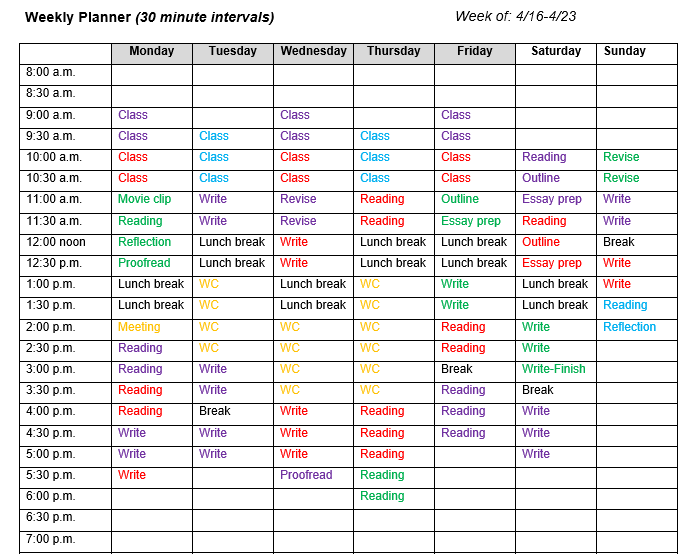Taking Life Week by Week
By Taylor
Like many other students, I’ve recently had to move back home. While I was happy to be reunited with my cat, all the upheaval (and my inability to go get work done at Davis) has made it difficult for me to stay as organized and on top of my work as I used to be. I’ve been using Trello to keep track of all my work and assignments since the start of spring semester, but I began to think that something similar to a traditional planner might also help me keep track of what needs to be done and when it needs to be done. So, I turned to the Learning Center’s weekly planners.
These planners can be found on the Learning Center’s tips and tools page, under “Own Your Calendar.” The Learning Center has calendars for finals, the end of spring semester, and spring semester as a whole, but I was most interested in the three titled “Weekly Calendar.” These three go from broad (the block calendar) to detailed (the thirty-minute calendar). I decided to try out the calendar with thirty-minute intervals, as I felt it would give me a little more flexibility when planning my schedule.

This is what my planner looked like after I finished filling it out (note: it actually extends all the way to 1 AM, so anyone who prefers working at night is in luck). To decrease the amount of text I would need to cram in each block, I decided to give each of my classes and commitments a unique color, which I then made a key for so that it would be easy to remember. After completing a block, I used the strikethrough option in Microsoft Word to cross it out. For anyone who prefers a more traditional calendar, these templates can also be printed. I prefer electronic versions, as I tend to leave papers lying around in random places, only to find them a month later.
I’ll admit it: I did not fully stick to my schedule. There were time blocks where I wanted to work on something else, or times when I didn’t want to do anything at all, but that’s OK. More than anything, the calendar actually made me less stressed about all the work that had piled up (three essays and my normal reading, thank you LWOC), because I knew that I had enough time to get everything done, even without working until nine or ten o’clock every night. As someone who has a hard time sticking to a set schedule, I found that the proof that I had plenty of time to get things done made filling out the calendar worth it despite not following through with it 100% of the time. Although I don’t see myself using a detailed planner like this regularly, I will keep it in mind as a resource that I can grab when my work load seems unmanageable, even if only for the stress relief it provides.
This blog showcases the perspectives of UNC Chapel Hill community members learning and writing online. If you want to talk to a Writing and Learning Center coach about implementing strategies described in the blog, make an appointment with a writing coach or an academic coach today. Have an idea for a blog post about how you are learning and writing remotely? Contact us here.

